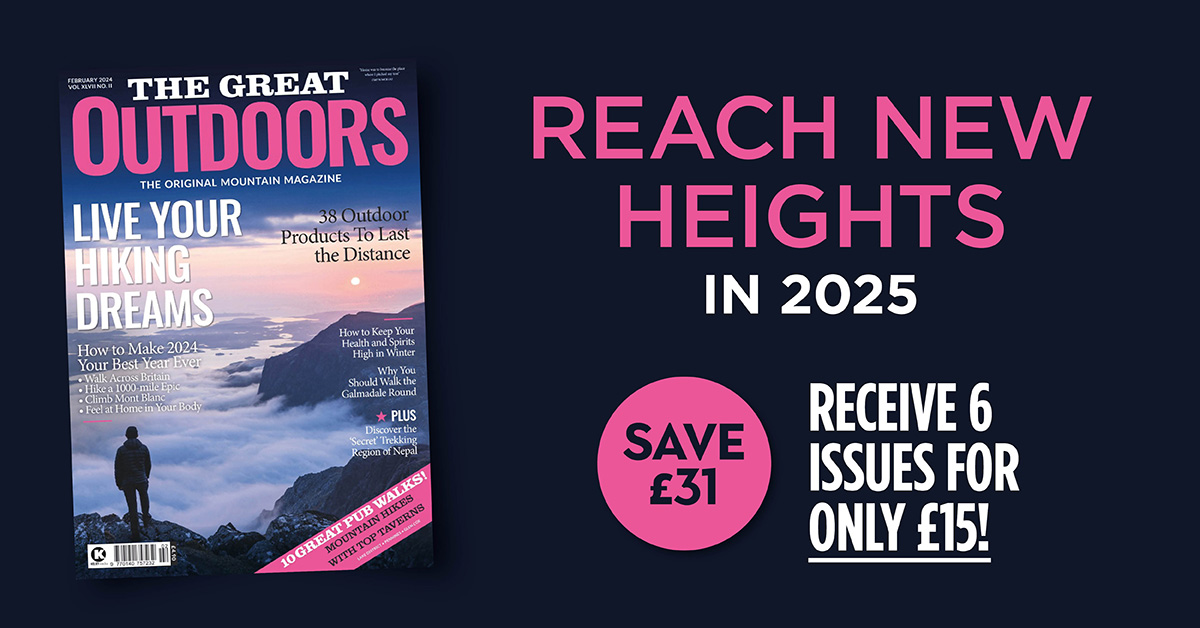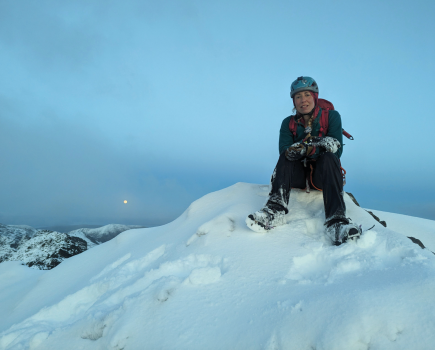Besides the company, there are some logistical benefits to sharing space in the outdoors. Here’s how hiking with a friend or your significant other can bring significant gains.
In the June issue of The Great Outdoors, Francesca Donovan and her partner go in search of Yr Wyddfa’s (Snowdon’s) quiet side with a camping trip circling the entire massif – and not once touching the busy summit. Here she gives some tips on how to share a trip and a tent with someone else – and gives the lowdown on a spacious shelter which is perfect for just that purpose, the MSR Tindheim 2.
Main image credit: Ben Cannon
- Take a load off
Carry one tent between two, if you can, in order to save weight and time pitching. But don’t let one person bear the brunt. Distribute weight proportionately considering size and strength. Split up tent pegs, poles and bulky items. Moreover, one person could carry items which must remain dry so you can get this bag undercover sooner without having to open it up to wet weather.
- Carry that weight
That being said, take responsibility for your own water. Sharing is caring but you both know your own needs best. Your backpacks should have hydration bladder compartments (and hipbelt pockets for trail treats). If you carry your own, you’ll both get to experience the delight of taking a drink and feeling the weight of your pack slowly lift as you rehydrate. Bliss.
- Plan together
A route planned together is a route halved. Okay, so that’s not true and you’ve still got walk the same amount of miles – but if you’re both on the same page, you’ll avoid the ‘how much further?’ conversations which do detract from the fun. Not only does planning together ensure you’re both comfortable with the route and pacing, it allows you to relax. If one person takes on planning responsibilities, they’re likely to be wracked with guilt should things go wrong. Luckily, Mother Nature is a good couple’s therapist but her hourly fee might cost you some joyful moments along the way.

Splitting different camping components is a great way of sharing weight. Photo: Ben Cannon
- Rest easy
Sharing small spaces can be challenging. Invest in a tent with enough room for each of you and your packs, either in a well-sheltered porch or within the main tent, ideally by your feet. Height enough for one person to sit up while the other wiggles into their clothes in the morning is also a luxury, but taller tents do generally have less stability in storms. Finally, with two bodies, ventilation is important – and not just for olfactory reasons but to avoid excess condensation, too. Some tents even have interior laundry lines to allow wet clothes to air.
- Stick to your side
The more limited space is, the more important it becomes. Good compartmentalisation solutions curtail the need to a build a fort to keep your camping companion off ‘your side’. Tent side pockets help to keep your belongings tucked away. (I hear there’s nothing worse than rolling over in your sleep onto a heavy-duty hair clip.)
- Double up
While any good individual sleeping bag is insulating – and stops your partner’s freezing feet from roaming – there’s nothing more effective (sorry, romantic) than sharing body warmth in a double bag. A double sleeping mat is ideal but not cheap. Sleeping mat connectors stop mats slipping and creating the uncomfortable camping equivalent of a crack in the middle of the bed.
‘The Palace’: Why the MSR Tindheim 2 tent is the best shelter for shared adventures

Fran and her partner Stew putting the spacious and light Tindheim 2 through its paces on Snowdon. Photo: Ben Cannon
MSR’s new two-person backpacking tent offers palatial space, robust protection, and a host of features to make it liveable and easy to us – but at a remarkably light weight.
If there’s one time you’ll be really grateful for a comfy night’s sleep, it’s on a multi-day adventure on the Snowdon Girdle. It’s a tough route and, in my humble opinion, better tackled together as even the hardiest hillwalker is likely to need a little encouragement or someone to bounce ideas off when it comes to footholds and navigational chin-scratchers.
For this, the Tindheim 2 – MSR’s new two-person backpacking tunnel tent – proved a solid and ultimately incredibly comfortable home for the night – we nicknamed it ‘the palace’! The tent body itself weighs in at just 2.48kg (5lb 5oz), and with a total packed weight of 3.2kg (7lb 1oz) incuding stuff sack and stakes, the Tindheim 2 is remarkably light for the veritable luxury it provides, and an excellent shelter for shared adventures.
The highly liveable design, with its spacious interior and vestibule, provided us with plenty of room to store our packs and for three people to shelter from the snow. The rectangular tunnel design gave plenty of headroom (1.01m/40 inches) and sitting space for both myself and Stew, who is 6ft 3in. A separate footprint allowed us to measure out the perfect spot before unpacking the Tindheim 2, and also provided extended vestibule protection for our gear against the wet ground.
The rainfly’s storm-pitch construction ensured the inner tent body stayed dry during a speedy setup, even in the snow. The interior laundry line, which allowed us to hang wet gear to dry without feeling cramped, was a hugely useful feature. Plenty of interior pockets on either side of the tent have been placed with two campers in mind. Rainfly vents are accessible from the inside so we could easily adjust to the conditions without leaving the tent.
A double-layer zip door included a mesh window panel for ventilation as well as a solid panel for weather protection and privacy. And the strong two-hoop design, heavy-duty cord adjusters, 3mm reflective guy lines and grommets for pole adjustments made us feel secure through the night, whilst the securable zip held the vestibule door securely closed against the wind.









